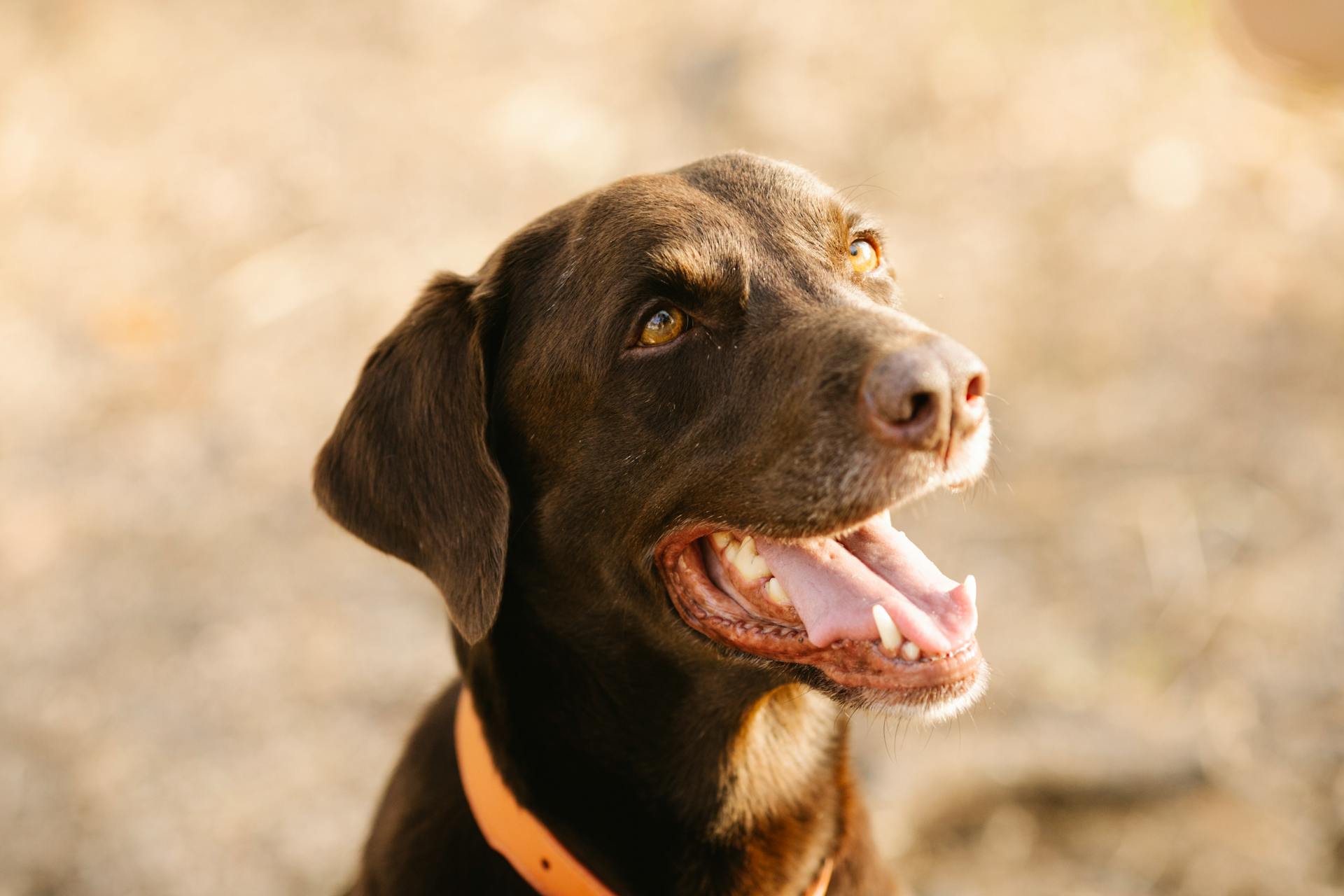
Food stuck in a dog's throat can be a terrifying experience for both the dog and its owner. This can happen when a dog eats too quickly or gulps down food that's too large.
Some common foods that can get stuck in a dog's throat include bones, meat, and even small toys. A dog's airway is narrow and can easily become blocked by a foreign object.
If you suspect your dog has food stuck in its throat, it's essential to remain calm and act quickly. A dog's airway can be blocked within seconds, so every minute counts.
Symptoms of a dog having food stuck in its throat include coughing, gagging, and difficulty breathing.
Prevention and Treatment
Prevention is key when it comes to avoiding food stuck in a dog's throat. Keeping an eye on what your pet is eating can help prevent choking. Make sure to avoid large chunks of food and bones in your dog's food.
Rawhide treats are a common cause of choking in dogs, so it's best to avoid them altogether. Household clutter can also be a hazard, so keep your home tidy to prevent your dog from finding and swallowing objects.
If your dog does get food stuck in their throat, general anesthesia is required for treatment. A veterinarian may try to remove the object using endoscopy, which involves inserting a long, narrow tube equipped with a camera and tools to maneuver the object.
Curious to learn more? Check out: Why Are Dogs so Food Motivated
What Are the Causes?
Dogs can ingest foreign objects that are too large or awkwardly shaped to pass through their esophagus, such as bones, rubber balls, or pieces of chew toys. This can cause an obstruction.
Food impaction is another common cause of esophageal obstructions, often occurring when dogs eat too quickly or don't chew their food adequately, causing large pieces of food to become lodged in the esophagus.
Certain medical conditions, like esophageal tumors or strictures, can also lead to blockages. Strictures are narrowings of the esophagus often caused by scarring from inflammation.
Recommended read: Do Dogs Chew Their Food

Dogs may accidentally ingest items like string, fishing hooks, or needles that can become lodged in their throats. This can happen when they're curious or exploring their surroundings.
Improper medication administration can also cause obstructions, particularly with pills or capsules that can damage the esophagus if not given with sufficient water.
Can You Prevent It?
Keeping an eye on what your dog is eating can help prevent choking. Make sure to avoid large chunks of food in your dog's food.
Rawhide treats are common causes of choking in dogs, so it's best to avoid them altogether.
A cluttered household can lead to a dog finding and swallowing something they shouldn't, so keep things tidy.
Treatment Options
Treatment options for esophageal obstructions in dogs depend on the type of obstruction, the dog's overall health, and the severity of symptoms. General anesthesia is always required.
A veterinarian may use endoscopy to remove the obstruction, especially if it's a sharp object like a fish hook. This involves inserting a long, narrow tube with a camera and tools to manipulate the object.

Blind retrieval is another option, where long forceps are used to grab the object and remove it through the mouth. If this isn't possible, the vet may try to push the object through the esophagus to the stomach, where it can pass on its own.
Surgery may be necessary if the object can't be removed through the mouth or stomach. This can involve making an incision in the chest or abdomen to access the esophagus. Esophagostomy is a type of surgery where the object is removed through the neck.
Even after the object is removed, the esophagus may need time to heal. Damage can lead to inflammation, and in severe cases, scar tissue can form, causing a stricture or narrowing of the esophagus.
Treatment may involve antacids, gastrointestinal protectants, and pain medication to help the dog recover. In some cases, a feeding tube may be used for 2-3 weeks to ensure the dog is getting the nutrients it needs.
A vet may also prescribe additional medications to reduce stomach acid and enhance gastrointestinal protection. Pain medications and antibiotics may be prescribed to prevent infection.
Here are some estimated costs for treating an esophageal foreign body:
- $500-$1,000 for objects stuck for a short period and removed using forceps/blind retrieval
- $750-$1,500 for objects stuck for a short period and removed using endoscopy
- $1,500-$3,000 for objects stuck for a longer period, complicated cases, or cases requiring surgery
Symptoms and Diagnosis
If you suspect that your dog has food stuck in their throat, it's essential to recognize the symptoms early on.
Gulping or repeated attempts to swallow can be a sign that something is blocking the esophagus. Gagging, retching, and coughing are also common symptoms.
Repeated attempts to vomit without being able to bring anything up can be a sign of an obstruction. Decreased interest in eating and/or drinking is another symptom to look out for.
Smacking/licking the lips and drooling (with or without blood in the drool) are also common indicators. Pawing at the mouth or face can be a clear sign of discomfort or distress.
Vomiting or regurgitation may be delayed several hours after eating, and pacing/restlessness can also be a symptom. Lethargy and pain with movement, especially when moving the head and neck, are also possible signs.
If you notice any of these symptoms, it's crucial to seek veterinary attention immediately.
Check this out: How to Stop Dog from Eating Other Dogs Food
Here are some common symptoms to look out for:
- Abdominal contractions (looks like dry heaving)
- Anorexia
- Depression
- Drooling
- Fever
- Lip licking
- Pacing
- Pawing at its face
- Salivation
A veterinarian may use various tests to diagnose the obstruction, including x-rays of the entire chest/neck to look for the object in the throat. They may also use contrast dye and retake x-rays, or snaking an endoscope down the esophagus to determine the object's location and any damage to the esophageal tissue.
Diagnosis and Treatment Methods
Diagnosing a food obstruction in your dog's throat is crucial for effective treatment. A thorough diagnosis typically involves a combination of medical history, clinical signs, and specialized diagnostic tests.
Your veterinarian may take x-rays of the entire chest/neck to look for the object in the throat. Some objects show up well on x-rays, while others can be more difficult to see. If your veterinarian suspects an object is stuck in the esophagus but cannot see it on x-ray, they may recommend using contrast dye and retake x-rays, snaking an endoscope down the esophagus, or performing a CT scan of the neck/chest to evaluate the esophagus.
Recommended read: Why Do Dogs Drool When They See Food
If your dog vomits or regurgitates while in the examination room, the appearance of bile after food has been in a dilated esophagus may be examined. Plain thoracic radiographs or fluoroscopy procedures may also be used to determine whether the dog is vomiting or regurgitating.
Diagnostic Methods
- X-rays of the chest/neck
- Contrast dye and retake x-rays
- Endoscopy
- CT scan of the neck/chest
- Plain thoracic radiographs or fluoroscopy procedures
Endoscopy
Endoscopy is a crucial diagnostic tool for detecting esophageal obstructions in dogs. It involves inserting a flexible tube attached to a camera into the dog's esophagus to get a detailed view of the interior.
This allows the veterinarian to directly visualize the obstruction, assess its severity, and sometimes even remove it during the procedure. Endoscopy is often considered the gold standard for diagnosing esophageal obstructions.
Under general anesthesia, a flexible endoscope is inserted through the dog's mouth and into the esophagus. The scope allows the veterinarian to locate the obstruction, which is then carefully removed using specialized tools.
In many cases, especially when the obstruction is discovered early, endoscopic removal is the preferred treatment. This procedure is less invasive and usually has a quicker recovery time.
Here are some key benefits of endoscopy in diagnosing and treating esophageal obstructions:
- Allows direct visualization of the obstruction
- Can be used to remove the obstruction during the procedure
- Less invasive than surgery
- Quicker recovery time
The cost to perform an endoscopy can range between $750-$1,500, depending on the complexity of the case and the location.
Medication
Medication can be used to help manage symptoms of an obstruction, but it's generally only an option for less severe cases.
Each of these treatments comes with its own set of risks and benefits, so it's essential to have a thorough discussion with your veterinarian to determine the most appropriate treatment plan for your dog.
Medications like muscle relaxants or anti-emetics can be used to help manage symptoms, but they should not replace endoscopic or surgical intervention for more serious cases.
A thorough discussion with your veterinarian will help determine the most appropriate treatment plan tailored to your dog's specific condition.
Recovery and Management
After a dog's esophageal obstruction is treated, recovery and postoperative management are crucial for a smooth and successful outcome. Your veterinarian will likely recommend a special liquid diet and demonstrate proper feeding tube care if a feeding tube is placed.
Most dogs make a full recovery, but some may develop complications like esophagitis, which is inflammation of the esophagus. This is managed with medications such as omeprazole to reduce stomach acid production.
Gastrointestinal protectants like sucralfate may be prescribed to protect damaged esophageal tissue. Your veterinarian may also recommend a canned, soft, or moistened diet for two to three weeks while the tissues heal.
Signs of infection, such as esophagitis, fever, and foul odor near surgical wounds, should be monitored closely. If an infection occurs, it may show up within two to five days.
Here are some common signs of complications:
- Esophagitis (inflammation that may damage esophagus tissues)
- Fever
- Foul odor near surgical wounds
- Heartburn
- Lethargy
- Pain near surgical wounds (outside of mild sensitivity)
- Pus near surgical wounds
- Regurgitation
- Swelling near surgical wounds
If you notice any of these symptoms or other behavioral changes, consult your veterinarian immediately. Swelling should diminish within a few days if there are no additional complications.
Veterinary Care and Costs
If your dog has a foreign object stuck in their throat, it's crucial to seek veterinary care immediately. The cost of treatment can vary greatly depending on the location, object, and duration of the blockage.
Your veterinarian will need to help retrieve the object, and in some cases, endoscopy may be required. The cost for this can range between $750-$1,500.
Even if you successfully dislodge the object, it's essential to take your dog to the veterinarian for an examination afterward. They may perform X-rays and administer treatment if needed to ensure your dog's throat or respiratory tract hasn't been damaged.
A foreign body airway blockage can be life-threatening, so don't hesitate to go to the emergency veterinary clinic if you're unable to remove the object yourself.
Cost to Remove Foreign Object from Dog's Esophagus
Removing a foreign object from a dog's esophagus can be a costly procedure, with prices varying depending on several factors. The cost can range from $500 to $1,000 if the object is stuck for a short period and can be retrieved using forceps or blind retrieval.
The method used to retrieve the object also plays a significant role in determining the cost. For example, if endoscopy is required, the cost can range from $750 to $1,500.
In more complicated cases, such as objects stuck for a longer period of time, the cost can be even higher, ranging from $1,500 to $3,000.
Take Your Dog to the Veterinarian
If you suspect your dog has a throat blockage, it's crucial to seek veterinary help immediately. Go to the emergency veterinary clinic if you can't remove the object yourself, as a foreign body airway blockage can be life-threatening.
Your veterinarian will perform X-rays to locate the object and check for any damage to the esophagus or surrounding tissues. If the object isn't visible on the X-ray, they may use contrast dye or snaking an endoscope down the esophagus to get a better look.
Even if you successfully dislodge the object, it's essential to take your dog to the veterinarian for a thorough examination. Your veterinarian can check for damage to your dog's throat or respiratory tract, and may perform additional diagnostics like bloodwork to evaluate your dog's health.
Here are some steps to take if you suspect your dog has a throat blockage:
- Go to the emergency veterinary clinic if you can't remove the object yourself
- Take your dog to the veterinarian for a thorough examination, even if you successfully dislodge the object
- Be prepared for your veterinarian to use X-rays, contrast dye, or an endoscope to diagnose the blockage
Frequently Asked Questions
How to dislodge food from a dog's throat?
To dislodge food from a dog's throat, try supporting their head downwards or lifting their hind legs like a wheelbarrow. If standing, use a firm upward and forward push just behind the rib cage to help clear the blockage.
How do you clear a dog's esophagus?
To clear a dog's esophagus, a veterinarian will remove foreign objects through the mouth, stomach, or surgically if necessary. This procedure is typically performed under anesthesia to ensure the dog's safety and comfort.
Sources
- https://www.vetmedutah.com/post/esophageal-obstruction-in-dogs
- https://www.petmd.com/dog/conditions/digestive/c_dg_esophageal_obstruction
- https://wagwalking.com/condition/esophageal-obstruction
- https://www.cuteness.com/article/foreign-objects-dogs-throat
- https://www.stortvet.com/oesophageal-foreign-bodies-in-dogs/
Featured Images: pexels.com


